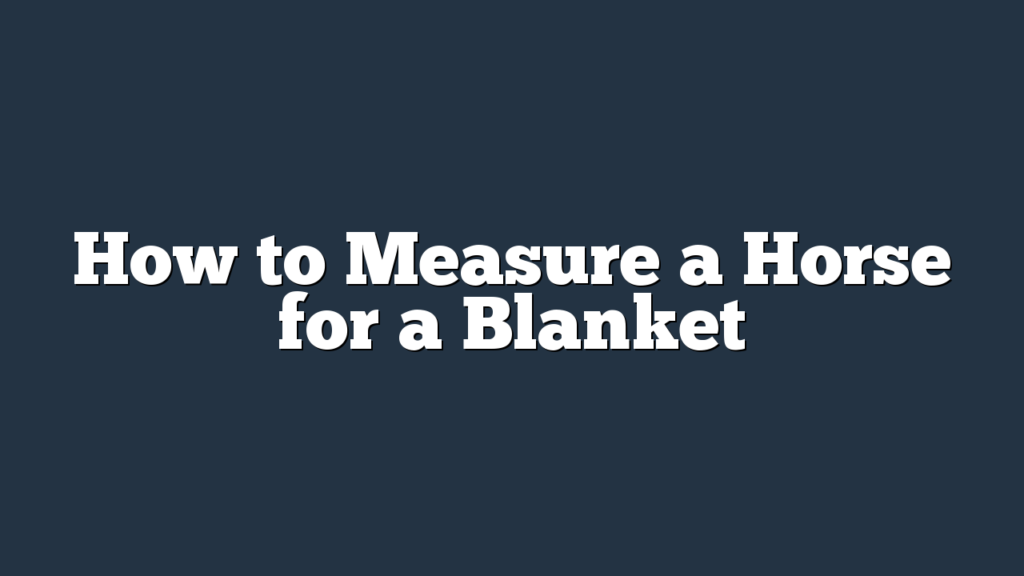Are you unsure about how to measure your horse for a blanket? Don’t worry, we’ve got you covered!
In this article, we’ll show you the step-by-step process of measuring your horse to ensure the perfect fit.
You’ll learn about the tools needed, common mistakes to avoid, and tips for achieving a proper blanket fit.
So grab your measuring tape and let’s get started!
Why Blanket Size Matters
You need to understand why blanket size matters before measuring your horse.
The importance of proper blanket fit can’t be overstated. A properly fitted blanket not only keeps your horse warm and protected, but it also ensures their comfort and overall well-being.
Ill-fitting blankets, on the other hand, can cause a myriad of problems. Firstly, a blanket that’s too small can restrict your horse’s movement, leading to discomfort and potential muscle strain. It can also cause rubbing and chafing, resulting in painful sores and skin irritations.
On the flip side, a blanket that’s too big can easily slip off or become tangled, posing safety risks to your horse. Moreover, an oversized blanket can create drafty gaps, allowing cold air to seep in and defeat the purpose of keeping your horse warm.
Tools Needed for Measuring
To measure a horse for a blanket, you’ll need a few essential tools. These include a measuring tape, a soft flexible ruler, and a sturdy weight tape. Each tool serves a specific purpose and ensures accurate measurements.
Understanding how to properly use these tools is crucial in obtaining the correct size for your horse’s blanket.
Essential Measuring Tools
Gather the necessary tools for measuring a horse for a blanket. Here are three essential measuring tools you’ll need:
- Measuring Tape: This is the most important tool for getting accurate measurements. Use a flexible measuring tape specifically designed for horses. It should have both inches and centimeters for precise measurements.
- Sturdy Helper: Enlist the help of a reliable assistant to hold the horse still during the measuring process. A calm and experienced person will ensure the horse remains steady and calm, allowing for accurate measurements.
- Blanket Size Chart: Have a blanket size chart handy to reference while measuring. Different brands may have slight variations in sizing, so it’s important to consult the specific brand’s chart to determine the correct size for your horse.
Proper Tool Usage
How can you effectively utilize the necessary tools for measuring a horse for a blanket? Proper tool usage is essential to ensure accurate measurements.
To measure a horse for a blanket, you’ll need a measuring tape and a helper. Start by standing on the left side of the horse and measure from the center of the chest, along the side, to the point of the buttocks. Make sure to keep the tape straight and level. Take note of the measurement in inches.
For different seasons, you’ll need to adjust the size of the blanket accordingly. In colder seasons, add a few inches to allow for layering and extra warmth. In warmer seasons, you may opt for a lighter blanket or choose not to use one at all.
Step 1: Measuring the Length
Start by positioning yourself next to your horse and grab a measuring tape. The first step in measuring your horse for a blanket is to measure the length. Here’s how you can do it:
- Measure the horse’s height: Stand next to your horse’s shoulder and extend the measuring tape from the ground to the highest point of the withers. Make sure the tape is straight and not slanted. This measurement will give you an idea of the blanket size your horse needs.
- Measure the horse’s girth: Position the measuring tape around the horse’s barrel, just behind the withers and the shoulder. Make sure the tape is snug but not too tight. This measurement will help you determine the correct size for the blanket’s belly straps.
- Measure the horse’s length: Starting from the point of the shoulder, run the measuring tape along the horse’s side, following the contour of the body, until you reach the point of the buttock. This measurement will give you the length of the blanket your horse requires.
Step 2: Measuring the Width
To continue measuring your horse for a blanket, position yourself next to your horse and assess the width using a flexible measuring tape. Measuring the width of your horse is an important step in ensuring the proper fit of the blanket.
Start by placing the measuring tape at the widest point of the chest, which is usually just behind the horse’s front legs. Wrap the tape around the chest, making sure it’s snug but not too tight. Take note of the measurement in inches or centimeters.
Next, move to the widest point of the shoulders, which is located between the withers and the base of the neck. Wrap the tape around this area, again making sure it’s snug but not constricting. Record this measurement as well.
Finally, you’ll need to measure the width of the hindquarters. This can be done by placing the measuring tape at the widest point of the rump, just below the tail. Wrap the tape around the hindquarters, ensuring a comfortable fit.
Once you have obtained these measurements, you can use them to determine the appropriate blanket size for your horse. Most blanket manufacturers provide sizing charts that correlate measurements to blanket sizes. If your horse falls between sizes, it’s generally recommended to go up to the larger size to allow for a more comfortable fit.
With these measuring techniques and the ability to adjust blanket size accordingly, you can ensure that your horse stays warm and protected during colder months.
Step 3: Measuring the Neck Opening
Continuing the assessment of your horse for a blanket, now it’s time to determine the neck opening measurement. The proper neck measurement is crucial to ensure a comfortable fit for your horse.
Here are three steps to help you get the right measurement and adjust the neck opening accordingly:
- Use a flexible measuring tape: Start by placing the measuring tape at the base of the horse’s neck, where the neck meets the body. Bring the tape up to the highest point of the withers, just behind the horse’s ears. Make sure the tape is snug but not too tight, as you want to replicate the fit of the blanket.
- Take note of the measurement: Once you have the measurement, write it down to reference later. Remember that different blanket brands may have different sizing charts, so it’s important to check the specific brand’s guidelines for the correct size based on the neck measurement.
- Adjust the neck opening: Most blankets have adjustable neck openings to accommodate different horse sizes. Check the blanket’s design to see if it has Velcro or straps that allow you to tighten or loosen the neck opening. Adjust the opening accordingly to ensure a snug but comfortable fit for your horse.
Step 4: Measuring the Drop
To measure the drop for a horse blanket, position the measuring tape at the center of the horse’s chest and extend it down to the point where you’d like the blanket to end. Measuring the drop is important because it ensures that the blanket provides adequate coverage and protection for the horse.
When measuring the drop, it’s important to consider the horse’s growth. Horses can experience growth spurts, so it’s essential to choose a blanket with some extra length to accommodate this.
Selecting the right fabric is also crucial when measuring the drop. Different fabrics have different levels of stretch and flexibility, so it’s important to choose a fabric that will allow the horse to move comfortably while still providing the desired coverage.
It’s also important to consider the climate and weather conditions in your area when selecting the fabric. For colder climates, a thicker and more insulated fabric may be necessary to keep the horse warm and protected. On the other hand, for warmer climates, a lighter and more breathable fabric may be more suitable.
Choosing the Right Blanket Style
When selecting the right blanket style for your horse, consider the overall fit and functionality. Here are three key factors to keep in mind:
- Blanket Materials: The material of the blanket is crucial for ensuring your horse stays comfortable and protected. Look for blankets made from durable and breathable fabrics such as nylon or polyester. These materials aren’t only tough enough to withstand outdoor conditions but also allow for proper ventilation, preventing your horse from overheating.
- Choosing the Right Weight: Blankets come in different weights, ranging from lightweight to heavyweight. The weight you choose should depend on the climate and the needs of your horse. For milder weather, a lightweight blanket will suffice, providing just enough warmth without causing overheating. In colder temperatures, opt for a heavier blanket with more insulation to keep your horse cozy and protected from the elements.
- Consider the Style and Features: Blankets come in various styles, such as turnout blankets, stable blankets, and cooler blankets. Turnout blankets are designed for outdoor use and provide waterproof and windproof protection. Stable blankets are ideal for indoor use, providing warmth and comfort in the barn. Cooler blankets are used for cooling down after exercise or as an additional layer under a turnout or stable blanket. Additionally, consider features like adjustable straps, belly bands, and tail flaps for a secure and comfortable fit.
Common Mistakes to Avoid
To ensure proper fit and avoid potential issues, take note of these common mistakes when measuring a horse for a blanket. It’s important to get the measurements right to ensure your horse stays comfortable and protected. Here are some common mistakes to avoid:
| Common Mistake | Why it Matters | How to Avoid |
|---|---|---|
| Measuring the wrong area | Measuring the wrong area can result in a blanket that is too tight or too loose, causing discomfort or potential injury to your horse. | Double-check the instructions and measure the correct area, usually from the center of the chest to the tail. |
| Estimating measurements | Guessing or estimating measurements can lead to an ill-fitting blanket that may rub or slide off. | Use a measuring tape to get accurate measurements. |
| Ignoring weight considerations | Failing to consider your horse’s weight can result in a blanket that is too tight or too loose. | Take into account your horse’s weight when selecting the appropriate size. |
| Not adjusting for breed differences | Different horse breeds have different body shapes and proportions. Neglecting this factor can result in an improper fit. | Research and consider any specific breed requirements when measuring your horse. |
| Not checking the fit | Even if you measure correctly, not checking the fit can lead to issues. The blanket should fit snugly but allow for freedom of movement. | After putting the blanket on, check for any tightness or looseness and make necessary adjustments. |
Tips for Proper Blanket Fit
To ensure a proper fit for your horse’s blanket and maximize their comfort and protection, there are a few tips to keep in mind:
- Proper Fit Importance: The importance of a proper fit can’t be overstated. A blanket that’s too small can cause discomfort and restrict movement, while a blanket that’s too big can slip and potentially cause accidents. It’s essential to choose the right size for your horse to ensure optimal comfort and freedom of movement.
- Choosing the Correct Size: When selecting a blanket, refer to the manufacturer’s sizing chart and measure your horse accurately. Take into account factors such as the horse’s height, weight, and body shape. Remember that different brands may have different sizing guidelines, so measure your horse each time you buy a new blanket.
- Check for Proper Coverage: Once you have the blanket on your horse, check to make sure it provides adequate coverage. The blanket should extend from the withers to the tail and shouldn’t be too tight or too loose around the neck, chest, and hindquarters. It should also have enough room for the horse to move comfortably.
Frequently Asked Questions
How Do I Determine the Correct Size of Blanket for My Horse?
To determine the correct size of blanket for your horse, use measuring techniques like measuring from the center of the chest to the edge of the tail. This helps in determining the blanket size accurately.
Can I Use a Regular Measuring Tape for Measuring My Horse for a Blanket?
Yes, you can use a regular measuring tape to measure your horse for a blanket. However, there are other measuring tape alternatives available. Common mistakes when measuring a horse for a blanket include not measuring from the withers to the tail and not accounting for the horse’s build.
Is It Necessary to Measure the Neck Opening Separately From the Length and Width?
When measuring your horse for a blanket, it’s important to measure the neck opening accurately. Common mistakes include not measuring separately, leading to a poorly fitting blanket and discomfort for your horse.
How Do I Measure the Drop of a Horse for a Blanket?
To measure the drop of a horse for a blanket, start by measuring from the highest point of the withers to the ground. This will help you determine the correct size blanket to fit your horse’s height.
Are There Any Specific Blanket Styles That Are Recommended for Certain Horse Breeds or Body Types?
For different horse breeds or body types, there are recommended blanket styles. Certain breeds may benefit from specific blankets that accommodate their unique proportions. Likewise, different body types may require tailored blankets for optimal fit and comfort.
Conclusion
In conclusion, correctly measuring your horse for a blanket is essential for ensuring a proper fit and maximum comfort. By following the steps outlined in this article and avoiding common mistakes, you can easily determine the right size for your horse.
Remember to consider the length, width, neck opening, and drop when measuring. Additionally, choosing the appropriate blanket style for your horse’s needs will further enhance their comfort and protection.



